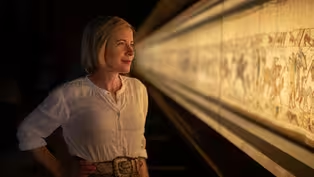
Coming Face to Face with William the Conqueror
Clip: Season 2 Episode 2 | 3m 35sVideo has Closed Captions
What is it like to come face to face with William the Conqueror?
What is it like to come face to face with William the Conqueror? Lucy Worsley examines three rare coins from the 1060s, which locals buried in the ground in fear as William's Army surged North to pacify York.
Problems playing video? | Closed Captioning Feedback
Problems playing video? | Closed Captioning Feedback

Coming Face to Face with William the Conqueror
Clip: Season 2 Episode 2 | 3m 35sVideo has Closed Captions
What is it like to come face to face with William the Conqueror? Lucy Worsley examines three rare coins from the 1060s, which locals buried in the ground in fear as William's Army surged North to pacify York.
Problems playing video? | Closed Captioning Feedback
How to Watch Lucy Worsley Investigates
Lucy Worsley Investigates is available to stream on pbs.org and the free PBS App, available on iPhone, Apple TV, Android TV, Android smartphones, Amazon Fire TV, Amazon Fire Tablet, Roku, Samsung Smart TV, and Vizio.
Providing Support for PBS.org
Learn Moreabout PBS online sponsorshipI wonder what it was like to experience harrying as a weapon of war.
I've come to York Castle to meet a senior curator at Yorkshire Museum.
Nice to meet you, Lucy.
Who has some unusual archaeological evidence.
Why did you suggest that we meet here at the top of the tower?
Well, the tower is perhaps the best example of William the Conqueror's attempt to pacify York and across the region really?
This building, the moss underneath it, was built in 1068 for William to try and control this unruly part of the country.
So this is perhaps the best symbol of the harrying of the North still standing.
Rebellious people in Yorkshire, right?
I mean, hard to believe, right?
But yes, Yorkshire and most of the north is in open rebellion against William for most of the late 1060s.
And what have you brought here?
They look very precious.
I have brought you three coins, which are the protagonists of 1066.
On the left here you have Edward the Confessor.
So his death in early 1066 sparks all of the events that happened later.
If I do that hopefully you get- I can see his little face, yes.
And is he wearing a crown, Andy?
He is wearing a crown.
So he's looking off to the right with a sort of pointy nose and he's wearing this rather elaborate crown and holding the sceptre so the symbols of state.
Okay.
So that's the ruler before the Battle of Hastings?
It is.
What are the other ones that you've got?
Sure.
This is Harold Godwinson.
Now, slightly less clear portrait, but hopefully you can see he's looking.
He's looking the other way, isn't he?
He's got quite chubby cheeks has Harold.
He has.
Is that really rare?
Yeah.
We only have two of Harold Godwinson.
We don't often bring this one out, so I'm pleased to be able to share it with you today.
What a treat.
So who's this one?
Now you're face to face with the man himself, William Duke of Normandy.
I have to say, I feel intimidated by being face to face with William Duke of Normandy.
I think he's made a very clever choice there to be looking right at me.
I find him more scary than Harold for that reason alone.
Maybe because I know about the harrying of the North and what he did.
I'm extrapolating here, but I just don't like the look in his eyes.
So did all these three coins belong to the same person?
No.
So these are from different hoards.
So we get groups of coins buried in the ground and we call them a hoard.
And why would they be burying their coins in the ground.
In a world before banks, you buried your money in times of challenge, times of crisis, and you come back and dig it up when the crisis blows over.
The crucial question in some ways is why didn't they come and dig them back up again?
And I guess if you're in York in the 1068 or 69, you know, there's an army coming towards you.
You bury your wealth, you might escape town and you might not ever be able to come and dig it back up again.
Gosh, that's horrifying to think of people in fear and panic thinking the Normans are coming and the people who buried these little coins never came back to get them.
Yeah, in some ways, the evidence of the coins, particularly the hoards from York, is some of the best archaeological evidence we actually have for the harrying of the North and its effect upon the people.
There are more coin hoards buried within the city walls of York than there are across the whole of South- Southern England at the same time.
The reason these were buried in the ground, the reason that we're looking at them today, is all because the person who had them was probably terrified of the arrival of the Norman Army and may have lost their life to us.
Video has Closed Captions
Preview: S2 Ep2 | 30s | Lucy investigates William the Conqueror. (30s)
William the Conqueror: The Bayeux Tapestry
Video has Closed Captions
Clip: S2 Ep2 | 3m 12s | It's over 230 feet long and its 900 years old. What is it? (3m 12s)
Providing Support for PBS.org
Learn Moreabout PBS online sponsorshipSupport for PBS provided by:

















